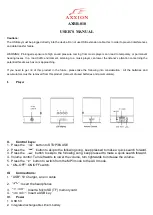
12
Insulation Test
Insulation resistance is a measure of the integrity of the
insulating materials that separate the electrical windings
from the generator’s steel core. This resistance can
degrade over time or be degraded by contaminants: dust,
dirt, oil, grease, and especially moisture. Most winding
failures are due to a breakdown in the insulation system. In
many cases, low insulation resistance is caused by moisture
collected when the generator is shutdown
Insulation resistance is measured with a megger (mega-
ohm meter). A megger measures insulation resistance by
placing 500 volts between the winding and the frame of the
generator. Caution must be taken to remove all electronic
devices (regulators, diodes, surge protectors, capacitors,
protective relays, etc.) from the winding circuit before
checking the insulation. Winding insulation can be checked
on the main stator, main rotor, exciter stator, and exciter
rotor. Minimum resistance is 2 mega-ohms. If the winding
resistance is low it must be dried (see maintenance section)
or repaired.
DIODE TESTING
If the generator is close coupled to an engine, it may be
necessary to "bar over" the engine in order to gain access to
a given area of the rectifier assembly.
NEVER
use the
generator's fan as a fulcrum to accomplish this. Use the
engine manufacturer's recommended practice to manually
turn over the engine. To prevent possible injury to
personnel, and damage to the equipment, ensure that the
engine cannot start during this procedure.
Remove the two main rotor leads and the three exciter rotor
leads from the rectifier assembly (figure 4). The rectifier
assembly is now electrically isolated from the generator.
The diodes remain mounted and the diode leads remain
connected to the terminal posts. Using an ohmmeter or a
battery light continuity tester, place one test probe on the
diode lead terminal post. In succession, touch the other test
probe to the lead screw hole in each heat sink. Reverse the
probes and repeat the procedure. You have now tested the
three diodes connected to this terminal post in both the
forward and reverse direction. Repeat the procedure using
the other diode terminal post.
FIGURE 3: DIODE POLARITY
When the positive test probe is connected to the diode's
anode and the negative test probe is connected to the
diode's cathode (forward biased), the diode will switch on
and conduct electricity (figure 3). This is observed by a low
resistance reading when using an ohm meter or the lighting
of the bulb when using a battery light continuity tester.
Reversing the test leads (reverse biased) will result in the
diode switching off and no electricity will be conducted. The
results of these tests should indicate one of three conditions:
1.
Good diode:
Will have a much greater resistance in
one direction than the other. Typical reverse biased
resistance will be 30,000 ohms or greater, while forward
biased resistance will be less than 10 ohms. The
battery-light tester will have the light "on" in one
direction and "off" in the other.
2.
Shorted condition:
Ohmmeter reading will be zero, or
very low in both directions. The continuity tester will
have the light "on" in both directions.
3.
Open condition:
Ohmmeter will have a maximum
(infinity) reading in both directions. Continuity tester
light will be off in both directions.
Diode failure after a 25 hour "run-in" period is generally
traceable to external causes such as a lightning strike,
reverse current, line voltage spikes, etc. All 6 diodes are
essentially in the same circuit. When a diode is stressed to
failure, there is no easy method to determine remaining life
in the other diodes. To avoid possible continued failures, it
is recommended that the entire rectifier assembly be
replaced rather than replacing individual diodes.
SERVICE
GENERAL
The service procedures given in this section are those which
can reasonably be conducted on-site with a minimum
number of special tools and equipment. All service
procedures should be conducted by qualified maintenance
personnel. Replacement parts may be ordered through an
authorized service center or directly from the factory
.
FIELD FLASHING
Restoring
Residual
Magnetism
(not applicable on PMG equipped generators)
To restore residual magnetism to the generator, connect a
12 volt battery to the exciter field while the generator using
the following procedure:
1. Shutdown the generator set.
Remove the exciter field
leads F+ and F- from the regulator.
Terminal End
Stud End
Anode
(+)
Cathode
(-)
Anode
(+)
Cathode
(-)
Forward
Reverse





































